Canyon with Great House and Moon
Pueblo Bonito, Chaco Culture National Historic Park, New Mexico, 1994 | 55.5 x 65.5 x 1.75 | $2,800
The central-western portion of Chaco Canyon, with Pueblo Bonito at bottom center. Pueblo del Arroyo is along the watercourse immediately above it. View is to the west, with the Chuska Mountains on the horizon.
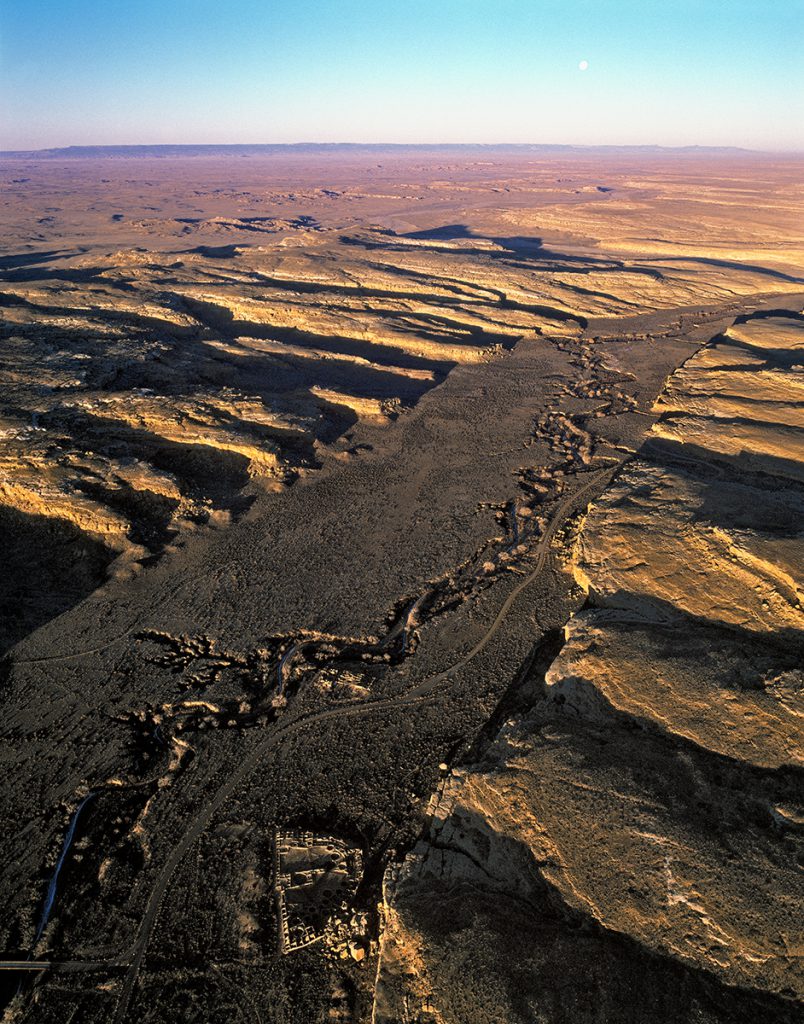
I could not live without being able to walk to those ancient sites—to connect with those sites, to be prayerful when I visit those sites. It is the same thing as breathing for me.
—Tessie Naranjo
Santa Clara tribal member
Canyon with Great Houses
Chaco Culture National Historic Park, New Mexico, 1994 | 55.5 x 65.5 x 1.75 | $2,800
The central-northern portion of Chaco Canyon, with prehistoric road segments visible in the upper right quadrant of the frame. Pueblo Bonito and Chetro Ketl, the two largest Great Houses in the park, are on the canyon floor at lower left and lower right. Pueblo Alto can be seen above the canyon rim at top right-center.
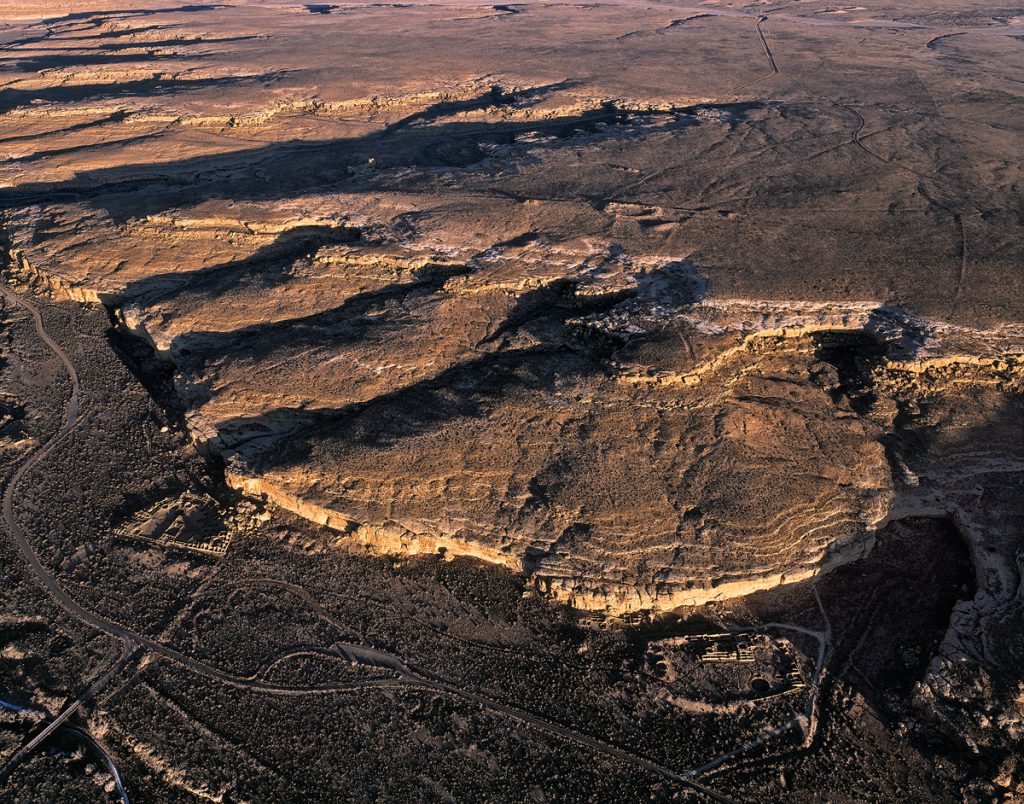
I went to Chaco Canyon in 2001. It was life altering. It’s one of those experiences that weeks later you’re still thinking about. We walked up to the top and looked down on that one ruin, Pueblo Bonito. I had no idea about that place. We stayed there two days, hiking and camping. And even when we got there, we got that feeling—that it’s really special. You’d think all the pueblos would look the same, but they didn’t. It was awesome. Driving away, we were silent for two hours because it was so awesome.
—Laura Mackin
Bisbee, Arizona
Cliff and Cave Dwellings with Snow
Puyé Pueblo, Santa Clara Indian Reservation, New Mexico, 2001 | 53 x 65.5 x 1.75 | $2,800
Cliff dwellings are built against the volcanic rock cliffs below Puyé Pueblo on the Santa Clara Indian Reservation. Today’s Santa Clara Indians are the descendants of Puyé’s inhabitants, who moved down from the high country in the 1500s to found a new village along the Rio Grande.
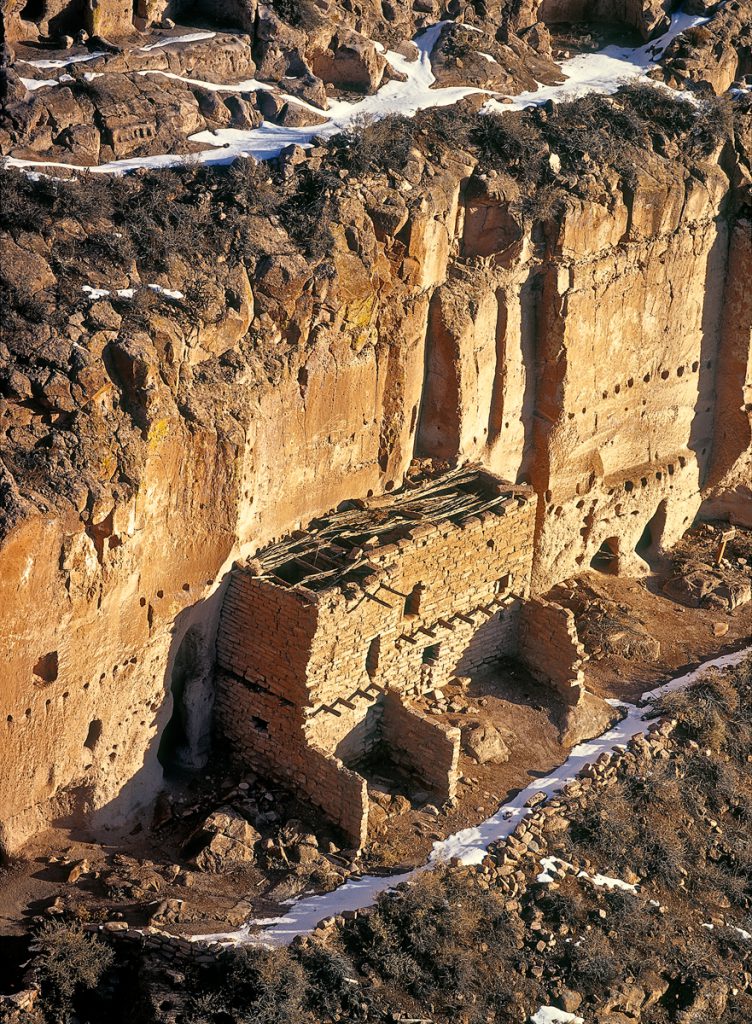
I feel a sense of history, of wonder how clan traditions actually were at these areas. Of course, we can only forever wonder, and try to relate the best we can. One thousand years ago is so long in the human mind. It also gives you pride, not a self-righteous pride, but honoring pride—it’s an honor to be there.
—Leigh J. Kuwanwisiwma, Greasewood Clan, director of Hopi Cultural Preservation Office
Excavated Pueblo by River
Salmon Ruins and San Juan River, Bloomfield, New Mexico, 1993 | 45 x 53.5 x 1.75 | $1,950
Constructed around AD 1090 as a Chacoan outlier, this three-story pueblo was extensively modified and used by local San Juan populations between AD 1115 and 1280. Protected by the Salmon family for generations, the site was purchased by a group of local concerned citizens in 1969, and is now managed by the San Juan County Museum Association. View is to the southwest, with the San Juan River in the middle distance.
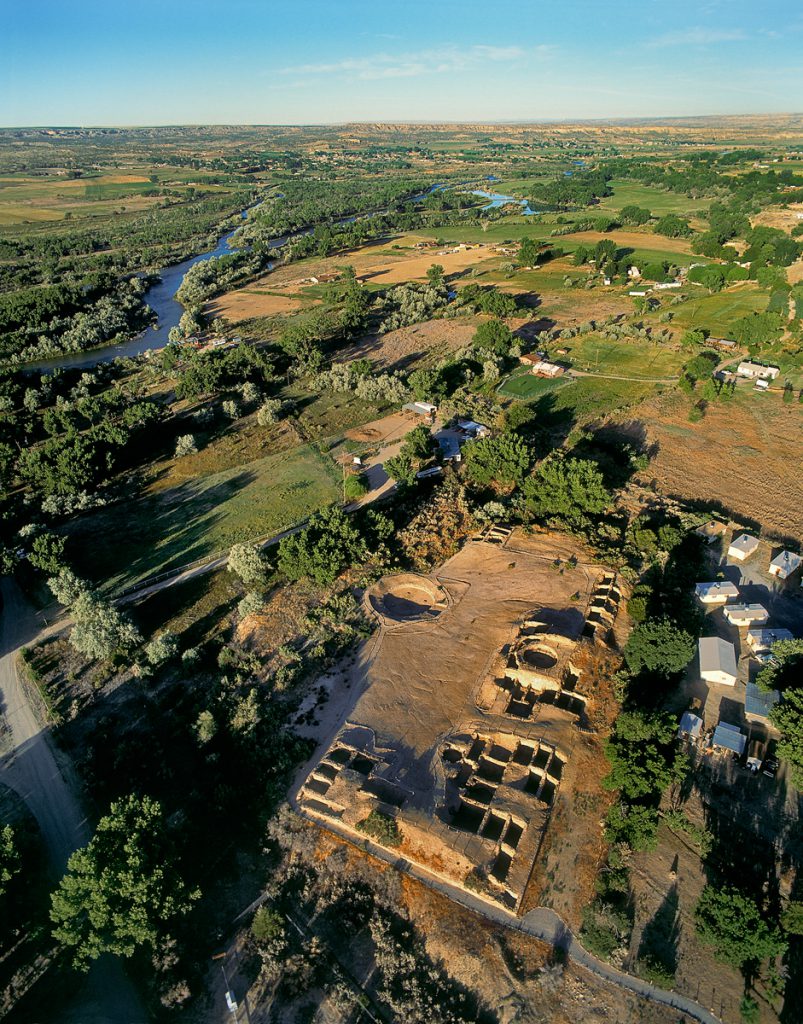
The Salmon family had protected their ruins. As I understand it, one guy was talking to George Salmon and he said, “George, I think I’ll come out and dig in your ruin.” And George said, “Oh, I don’t think you will.”
—Alton James, member of the San Juan County Museum, an association that organized the local community to purchase and protect the Salmon Ruins in northwestern New Mexico in the late 1960s.
Great House above Canyon
Peñasco Blanco, Chaco Culture National Historic Park, New Mexico, 1994 | 55.5 x 65.5 x 1.75 | $2,800
Peñasco Blanco, one of the 14 Great Houses in Chaco Canyon, at sunset. Built between AD 850 and 1125, the multistoried pueblo overlooks the confluence of the Chaco and Escavada washes at the northwest end of the canyon. A prehistoric road segment is visible to the right of the main ruin.
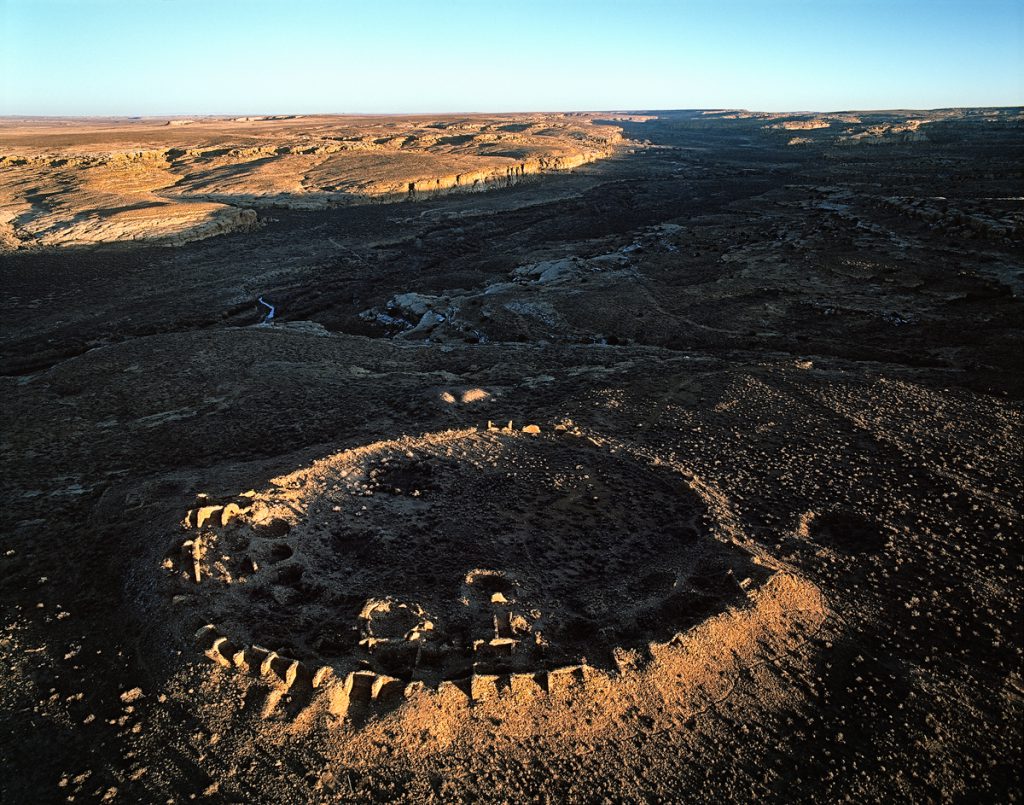
Folks are always attracted—whether it’s the archaeologists or anybody else out there—by the “big bumps” on the landscape, whether it’s Egypt or anywhere else. We all tend to run for the big one. Maybe it’s just human nature. Maybe it’s because you can climb up on them and see farther…We human beings are fairly fragile, as far as how we deal with life, so those big things are impressive to us. But more importantly, if we step back and start looking at the smaller things that make up the whole, they are also impressive in their own right.
—Thomas C. Windes
National Park Service archaeologist, thirty-year Chaco Canyon scholar
Great House with Reconstructed Kiva
Aztec Ruins National Monument, New Mexico, 2002 | 53 x 65.5 x 1.75 | $2,800
Established in 1923, this national monument protects a collection of Chacoan outliers, occupied in the AD 1100s and 1200s. These ruins are large, well-preserved, carefully interpreted, and easily accessible, making them a much-visited Ancestral Puebloan site. It is thought that Chacoans from Salmon Ruin moved north in the 1100s to build Aztec Ruins. This view is from the north, with the visitors center behind the trees in the upper right frame. Aztec Ruins was named a World Heritage Site in 1987.
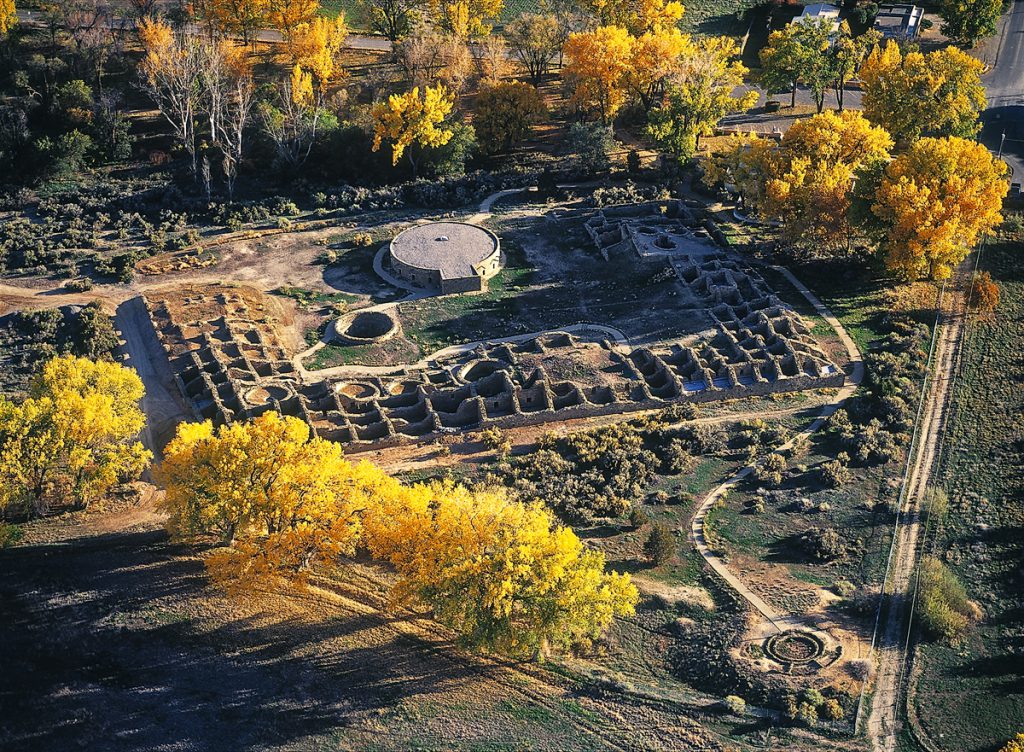
Hopefully, Aztec will continue to be a special kind of National Monument, being located right here in the outskirts of an existing community. A lot of the better-preserved ruins are in more remote areas, an undeveloped ruin where you have to crawl thorough greasewood and use your imagination. This one is very extensively excavated and well maintained; it’s accessible, whether you’re handicapped, or with children or a family. Anyone can come here. There is a very strong need for people who are not so adventurous, or those who are in one way or another handicapped, to do that. You can very much appreciate this ruin from a wheelchair, or even if you’re blind. In the Great Kiva you can walk up and duck your head and you’ll just sense a lot of what the place is all about—without even having to open your eyes.
—Gary M. Brown
National Park Service archaeologist, Aztec Ruins National Monument
Great Houses with Roads
Pueblo Bonito and Pueblo Alto, Chaco Culture National Historic Park, New Mexico, 1994 | 55.5 x 65.5 x 1.75 | $2,800
The central-northern portion of Chaco Canyon, with prehistoric road segments visible in the upper half of the frame emanating from Pueblo Alto. Pueblo Bonito is at the base of the cliff at the bottom of the frame. These roads linked sites both within the canyon itself and beyond. Chacoan roads have been identified on aerial photographs well into Colorado and Arizona.
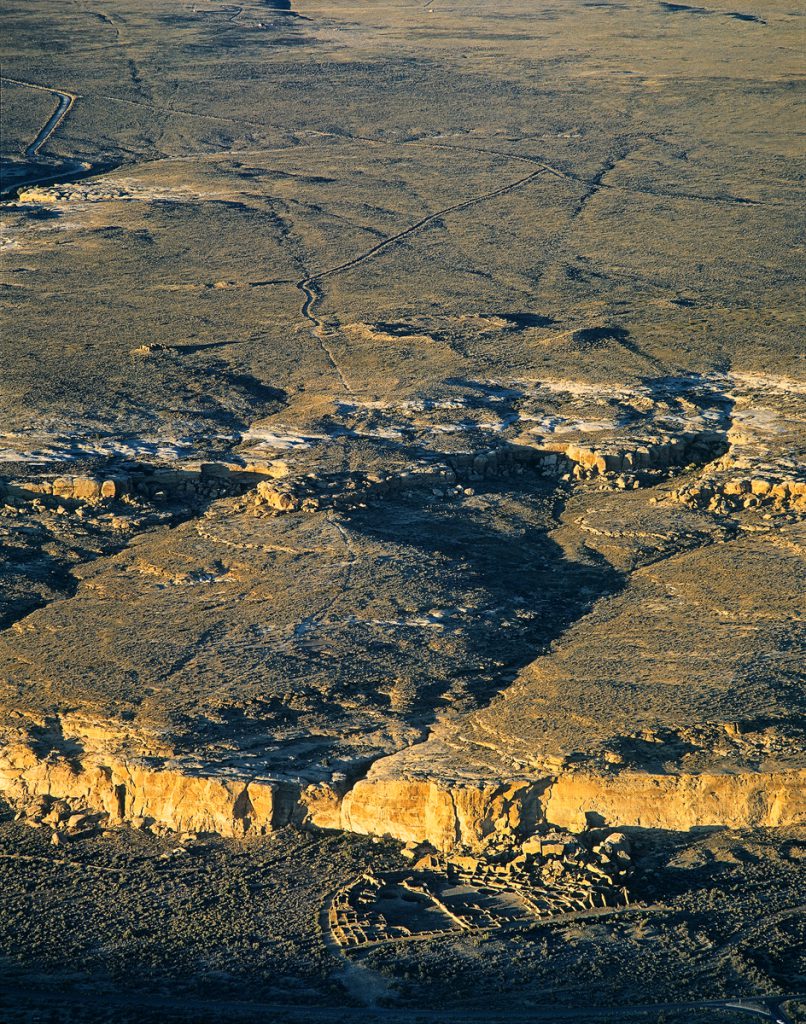
Pueblo Room Blocks in Snow
Puyé Pueblo, Santa Clara Indian Reservation, New Mexico, 2001 | 53 x 65.5 x 1.75 | $2,800
This is one of the largest prehistoric pueblos in New Mexico, which at its peak in the 1400s had two- and three-story sections with some one thousand rooms. Today’s Santa Clara Indians are the descendants of Puyé’s inhabitants, who moved down from the high country in the 1500s to found a new village along the Rio Grande.
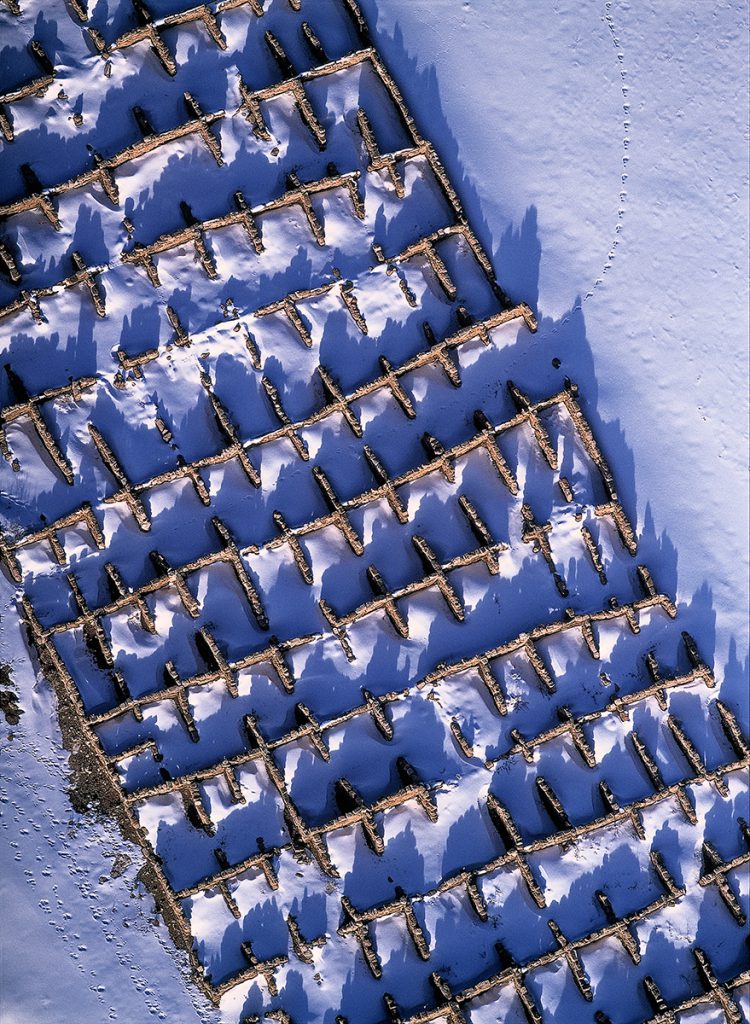
Pueblo Ruin above River at Sunset
Teypana Pueblo, Rio Grande, Socorro, New Mexico, 2003 | 32.5 x 39 x 0.875 | $975
Site of Teypana Pueblo, a village inhabited by Piro Indians at the time of European contact. Its sister village, Pilabo, was across the river to the west. That location is now occupied by Socorro, New Mexico.
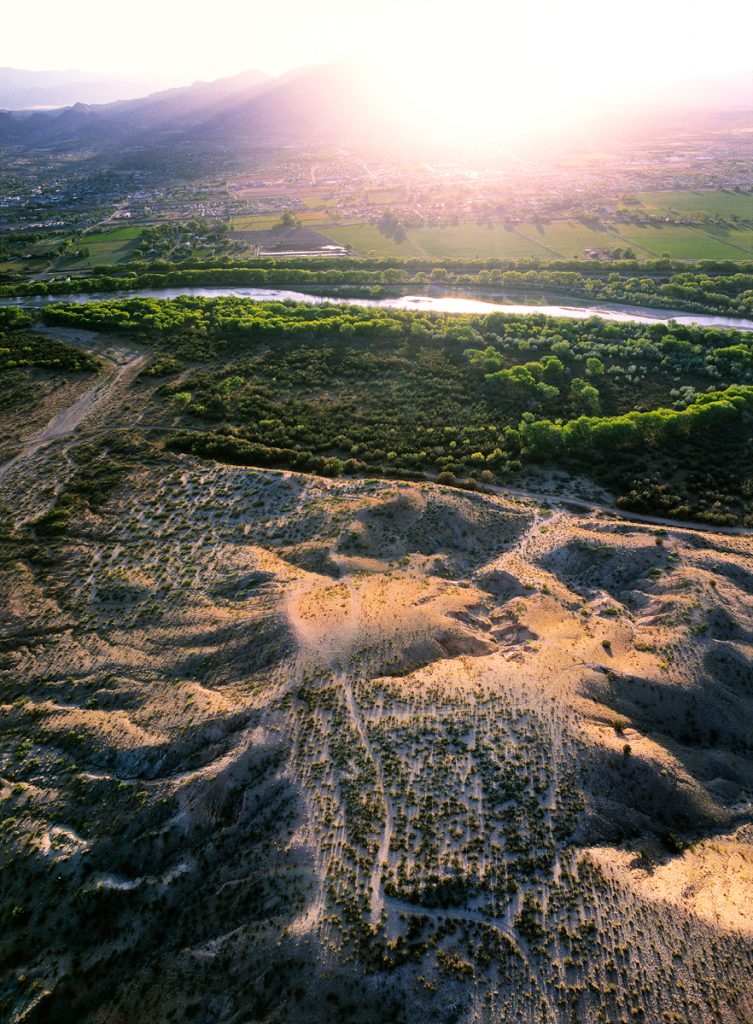
Archaeology is so different today. It used to be nothing more than rich men digging wherever they wanted to dig. Now the public is involved…Everyone is curious where they came from and where other people came from…Archaeology is not an isolated little academic pursuit.
—Alan Ferg, archivist
Arizona State Museum, Tucson, Arizona
Pueblo Ruin with Reconstructed Kivas
Kuaua Pueblo, Coronado State Monument, Bernalillo, New Mexico, 2003 | 43 x 53.5 x 1.75 | $1,950
Spanish explorer Coronado and his party camped near the Tiwa pueblo of Kuaua (“evergreen”) in 1540. By the time that Oñate arrived in this area in 1598, the village was largely unoccupied.
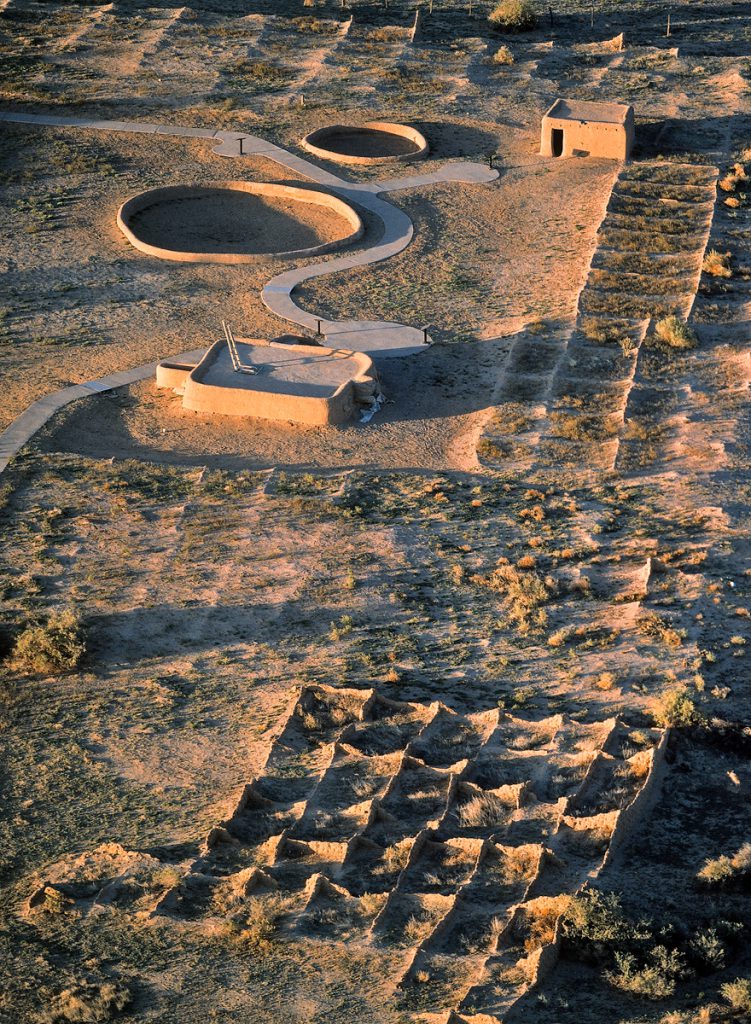
And in the most fundamental way—which is a religious, cosmological way—those places may be ruined, but they certainly are not abandoned. They are alive and present in the consciousness of us living Native American people.
—Leslie Marmon Silko
Laguna tribal member and novelist
Pueblo Ruins and Cliff Dwellings in Snow
Puyé Pueblo, Santa Clara Indian Reservation, New Mexico, 2001 | 43 x 53.5 x 1.75 | $1,950
This is one of the largest prehistoric pueblos in New Mexico, which at its peak in the 1400s had two- and three-story sections with some one thousand rooms. Today’s Santa Clara Indians are the descendants of Puyé’s inhabitants, who moved down from the high country in the 1500s to found a new village along the Rio Grande.
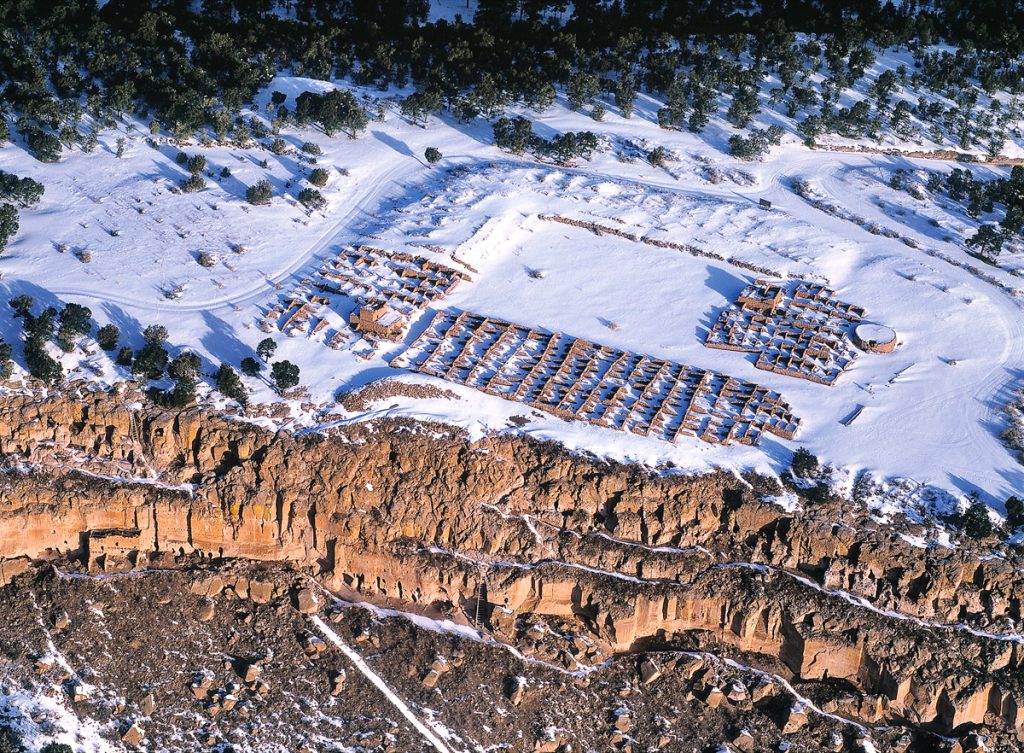
River with Hilltop Terrace Site
Gila River and Canador Peak, New Mexico, 2001 | 43 x 53.5 x 1.75 | $1,950
Canador Peak, along the Gila River north of Lordsburg in southwestern New Mexico. This lone summit is crowned with prehistoric rock terraces known as trincheras, which have been dated to AD 200 to 500. This view is to the northwest across the Gila River in the foreground.
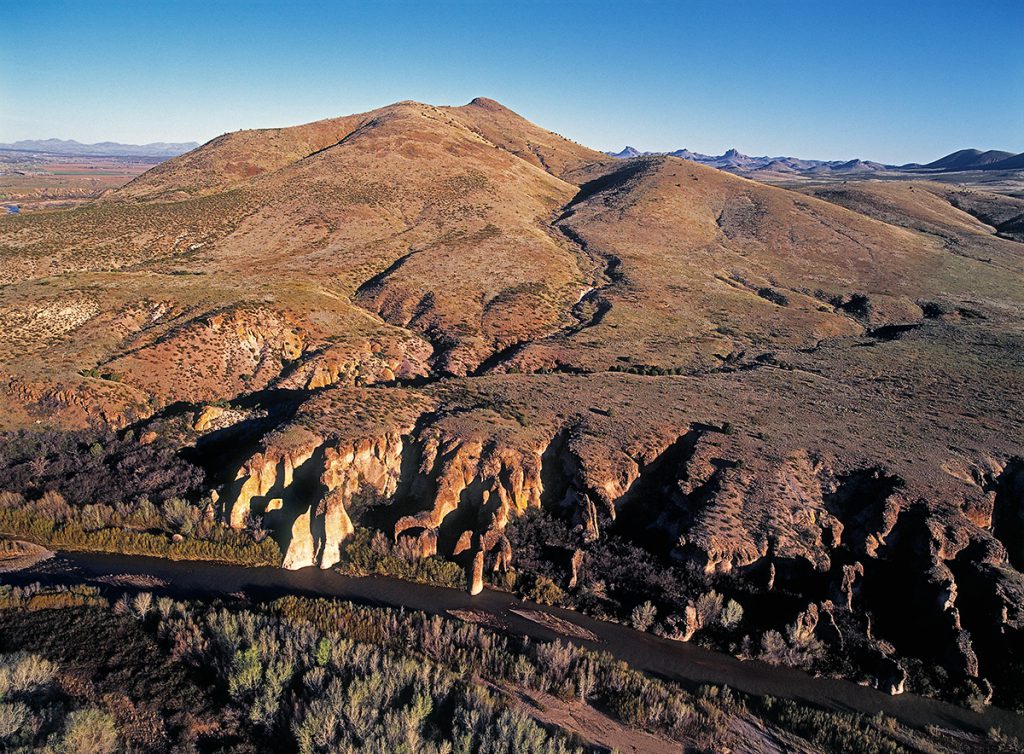
I’m really interested in how the Indians lived—that’s most the most interesting thing. For me, it’s not collecting things, but questions of what they grew, what they hunted…I think it’s human nature to want to know how people lived.
—Mary Smallhouse
Redington, Arizona
Room Blocks at Corner of Great House
Aztec Ruins National Monument, New Mexico, 2002 | 43 x 53.5 x 1.75 | $1,950
Northeast corner of Aztec Ruins at Aztec Ruins National Monument in Aztec, New Mexico.
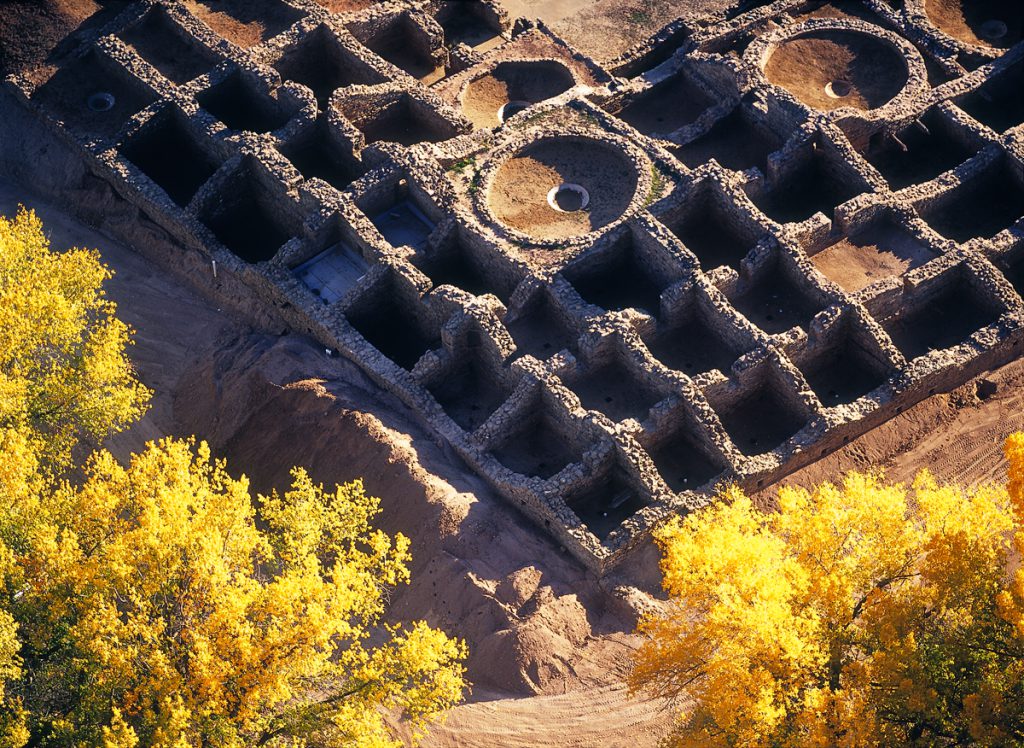
Site of Pueblo across River from City
Teypana Pueblo ruins, Rio Grande, Socorro, New Mexico | 32.5 x 39 x 0.875 | $975
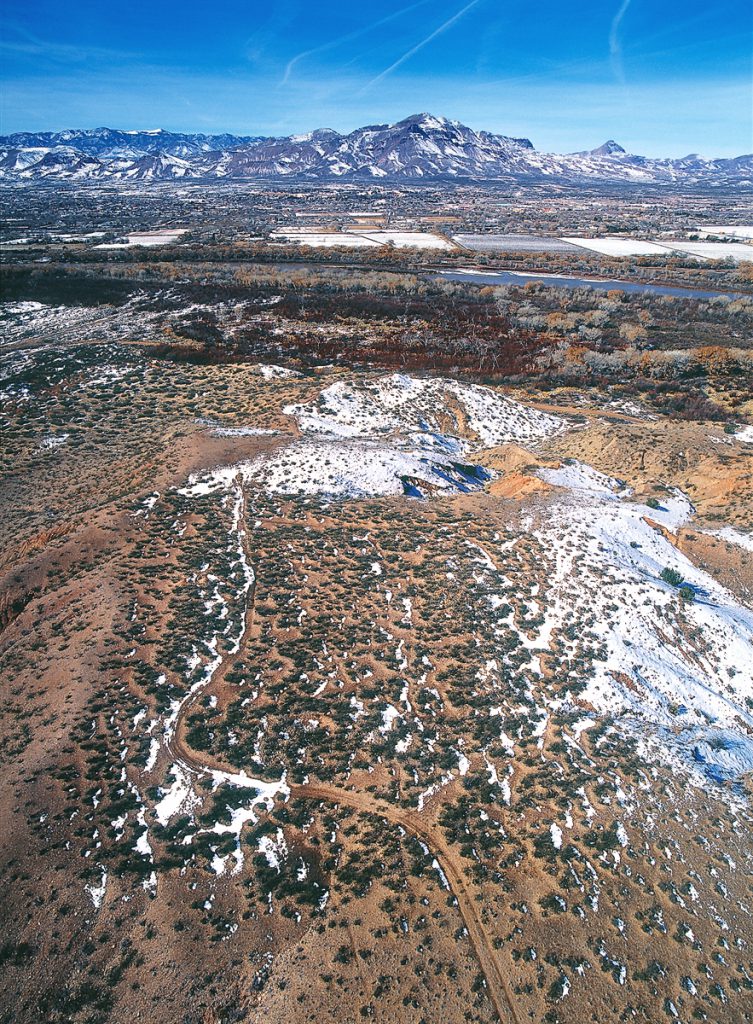
Summit with Terraces at Sunrise
Canador Peak, Gila River Valley, New Mexico, 2000 | 32.5 x 39 x 0.875 | $975
Canador Peak, along the Gila River north of Lordsburg in southwestern New Mexico. This lone summit is crowned with prehistoric rock terraces known as trincheras. These distinctive rock features have been found throughout the American Southwest and Mexican Northwest. Their purposes range from living spaces to agriculture and defense. The Canador Peak trincheras dates to AD 200 – 500. This view is to the northwest at sunrise.
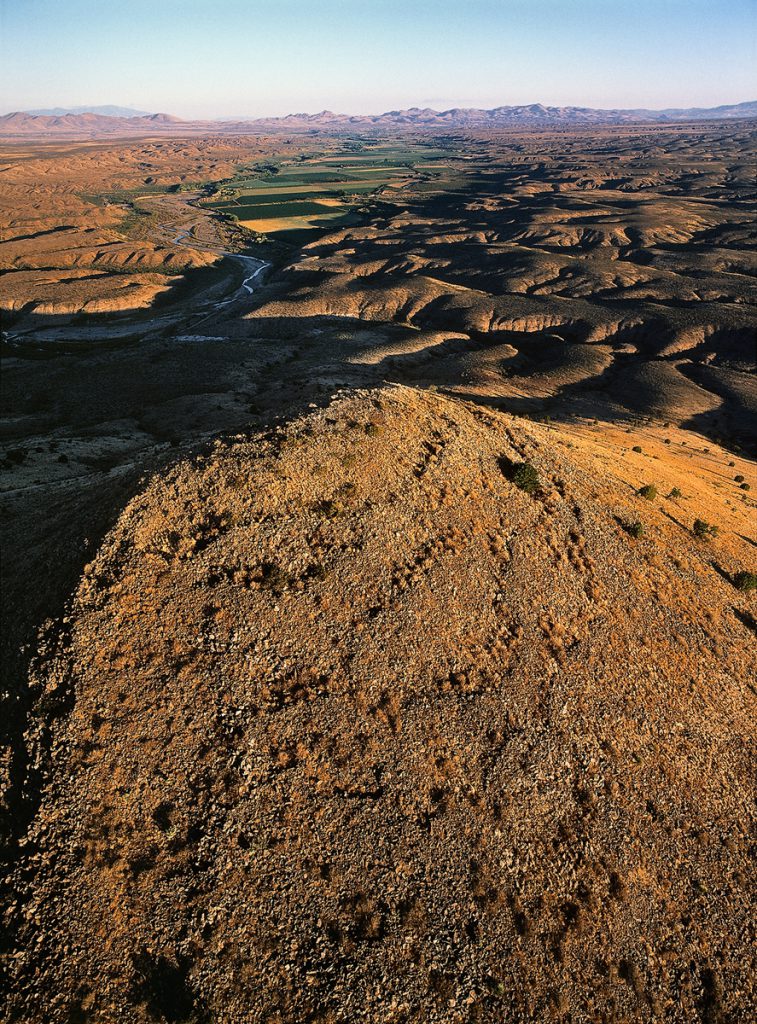
Querencia is that love of place—ensouling. The land ensouls you…I think you’re born with that in your genes when you’re born on this type of landscape. When you’re young, you don’t see it that way, but the older you get the more attached you become to the landscape.
—Juan Estevan Arellano, journalist and descendent of sixteenth-century Spanish settlers of Embudo, New Mexico
Trail through Desert
El Camino Real in Jornada del Muerto, Socorro County, New Mexico, 2001 | 43 x 53.5 x 1.75 | $1,950
Low aerial view of the Jornada del Muerto, a stretch of desert in central New Mexico. This rutted trail may be part of the Camino Real, the colonial-era road between El Paso and Santa Fe. The passage across the desert east of the Rio Grande was dreaded because of the lack of water and threat of attack. In this view to the south, the Fra Cristobal Range dominates the horizon.
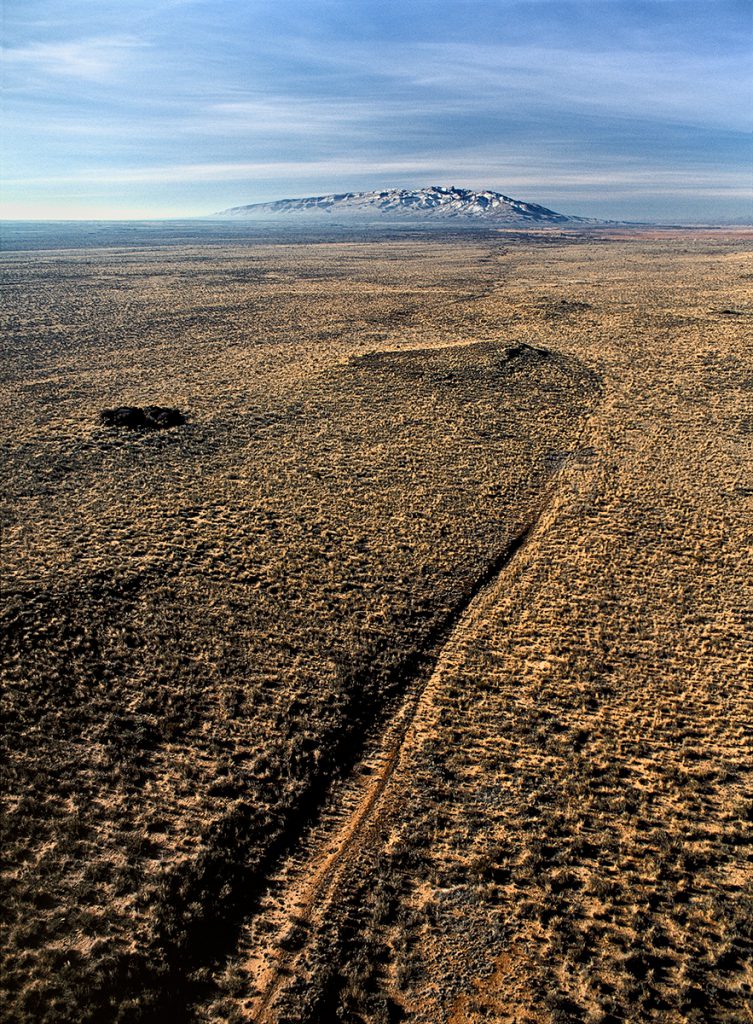
The idea of wilderness is such a peculiar idea. We revere the empty land and the nature-oriented values of American culture. The fact is, there was never any empty land. Everything was occupied when Europeans got to North America. We did a lot of work as a society to get people off of the land. And it was only after we got rid of the native people who were living in these places and had thereby somewhat domesticated the land that we were willing to contemplate institutions like national parks, which are founded on a mythology of pristine nature. But the people were missing.
—William deBuys, environmental historian and professor
College of Santa Fe